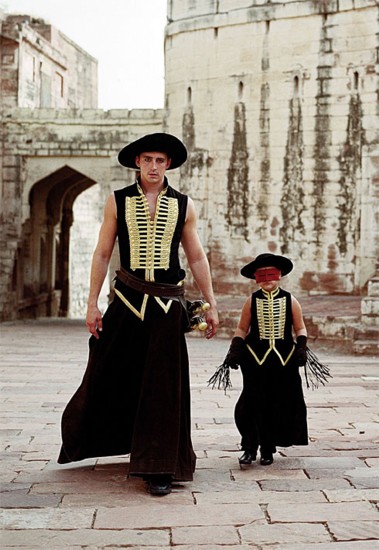|
Reviews of Recent Independent, Foreign, & Documentary Films in Theaters and DVD/Home Video
Produced & Directed by Tarsem Singh Written by Dan Gilroy, Singh & Nico Soultanakis, based on the 1981 film Yo Ho Ho, written by Valery Petrov Director of Photograhy, Colin Watkinson Edited by Robert Duffy Music by Krishna Levy Released by Roadside Attractions India/UK/USA. 116 min. Rated R With Lee Pace, Catinca Untaru, Justine Waddell & Daniel Caltagirone It took commercial and music video director Tarsem Singh almost 15 years to scout various countries (there are, according to the press notes, some 26 in all spanning the globe), and the only shame is that it didn’t come together sooner. Like The Fountain for Darren Aronofsky, this has been a passion project for Singh. In the end result, he’s crafted a work of visual mastery: perfect compositions, intense costume design, and a vibe between what is real, what is imagined, and what ends up merging in the minds of the two principle characters. The main part of the film is in a hospital in 1915 Los Angeles. Alexandria (first time Romanian actor Catinca Untaru) is there to heal a broken arm. Wandering around the hospital grounds, she is befriended by Roy (Lee Pace of Pushing Daisies fame), a stunt man seriously injured. He starts to tell the precocious and very young girl a story, an epic with various colorful bandits and figures of history (like Charles Darwin), who are all on a quest of revenge against the nefarious, cruel Odious (Daniel Caltagirone). He tells this story sporadically, and in order to continue, he cons her into sneaking around to find him bottles of morphine, not simply for his injury but to push down the pain of losing the love of his life (Justine Waddell). This is the basic idea, anyway, and one that owes debts to recent fare (Big Fish’s tall tale storyteller and archetypes, or Pan’s Labyrinth’s daring of using a child’s POV to dart between the fantastical and reality) and the classics (The Wizard of Oz as an obvious comparison with the characters in the revenge-quest story all played by characters who also appear at the hospital – this eventually includes Roy and Alexandria as masked bandits). However, its most direct influence is an obscure Bulgarian film called Yo Ho Ho, which was about an actor who told a story to a young boy in exchange for the boy retrieving for him poison. And yet, The Fall’s completely a work of a director in charge, a singular vision that makes one remember the flights of fancy possible in both storytelling and moviemaking. Singh’s work as a filmmaker is often fearless, with seamless transitional shots (Roy’s hand on a cup of coffee transfers into the fantasy world as a hand on a bloody body) and pure surrealism (a series of images edited for the impact of viewing a commercial on acid, with stop-motion animation and contorted wide shots). And he also has a command of making the material in the story correspond wonderfully with the characters in the hospital. At first, things are fairly lighthearted and very funny – swimming elephants, Darwin in a pimp coat – but then Singh drives the story into extremely tragic and harrowing terrain as the avengers near Odious’s fortress are overcome by his many henchmen. He cuts between characters in one realm to another, and soon enough the physical states as well (Roy’s morphine use affecting his alter ego in the fantasy story).
It would be one thing if it were all style. That might be enough to suffice the senses for a couple of hours, like Singh’s 2000 film The Cell.
But as I pondered the movie some time after it ended, I realized that there was more than met the eye in regards to substance. Aside from the
excellent casting, there’s a sense of the atmosphere that the director captures incredibly, of fun escapism turning sour and dark as the pain grows
for Roy and hope decreases steadily for Alexandria that good will conquer evil in Roy’s story. And yet in spite of the saddest death of a monkey I’ve
ever seen on film, Singh ends his film on a note of the miraculous, as images of silent film action-comedy, like Buster Keaton’s, flow on the
screen. It’s a wholly satisfying experience.
Jack Gattanella
|


